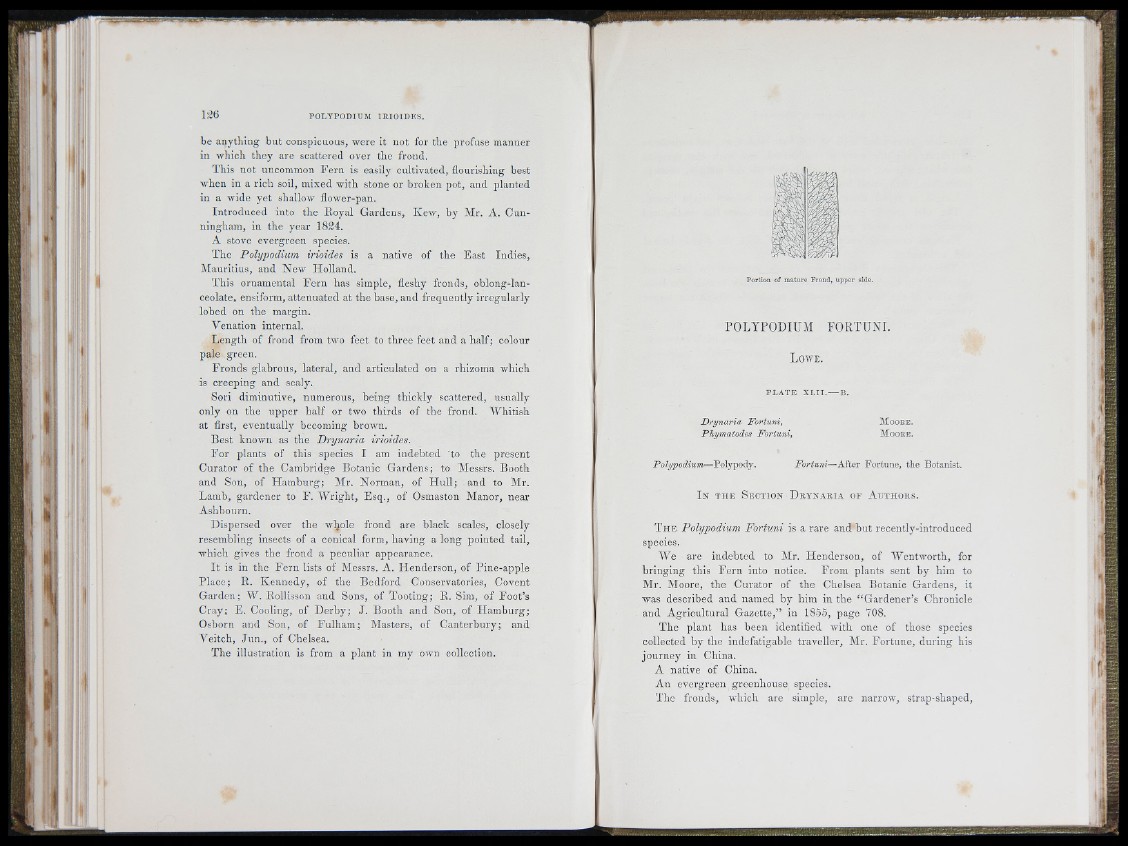
be anything b u t conspicuous, were it not for the profuse manner
in which they are scattered over the frond.
This not uncommon F e rn is easily cultivated, flourishing best
when in a rich soil, mixed with stone or broken pot, and planted
in a wide yet shallow flower-pan.
In tro d u c ed into the Eoyal Gardens, Kew, by Air. A. C u n ningham,
in the year 1824.
A stove evergreen species.
The Polypoditun irioides is a native of the E a st Indies,
Alauritius, and N ew Holland.
This ornamental F e rn has simple, fleshy fronds, oblong-lanceolate,
ensifonu, attenuated at the base, and frequently irreg u la rly
lobed on the margin.
Venation internal.
L ength of frond from two feet to three feet and a half; colour
pale green.
Fro n d s glabrous, lateral, and articulated on a rhizoma which
is creeping and scaly.
Sori diminutive, numerous, being thickly scattered, usually
only on the u p p e r h a lf or two th ird s of the frond. AVhitish
at first, eventually becoming broivn.
Best known as the D r yn a ria irioides.
F o r plants of this species I am indebted 'to the present
Curator of the Cambridge Botanic G ardens; to Alessrs. Booth
and Son, of H am b u rg ; Air. Norman, of H u ll; and to Air.
Lamb, gardener to F. AVright, E sq ., of Osmaston Alanor, near
Ashbourn.
Dispersed over the wljole frond are black scales, closely
resembling insects of a conical form, having a long pointed tail,
which gives the frond a peculiar appearance.
I t is in the F e rn lists of Alessrs. A. Henderson, of Pine-apple
P la c e ; H. Kenn ed y , of th e Bedford Conservatories, Covent
G a rd en ; AA'". Eollisson and Sons, of T ooting; E . Sim, of F o o t’s
Cray; E . Cooling, of D e rb y ; J . Booth and Son, of H am b u rg ;
Osborn and Son, of F u lh am ; Alasters, of C an te rb u ry ; and
Veitch, Ju n ., of Chelsea.
The illustration is from a plant in my own collection.
POLYPODIUJI FORTUNI.
L o w e .
p l a t e X L I I . — B.
D ry n a ria Fortuni,
Phymatodes Fortuni,
M o o e e .
A Io o e e .
Polypodium—Polypody. F o r tu n i— X ite r F o rtu n e , th e Botanist.
I n t h e S e c t i o n D r y n a r i a o f A u t h o r s .
T h e Polypodium F o rtu n i is a rare and b u t recently-introduced
species.
AAY are indebted to Air. H en derson, of AVentworth, for
b ringing this F e rn into notice. From plants sent by him to
Air. Aloore, the Curator of the Chelsea Botanic Gardens, it
was described and named by him in the “ G a rd en e r’s Chronicle
and Ag ricu ltu ra l Gaze tte,” in 18-55, page T08.
T he plant has been identified with one of those species
collected by the indefatigable traveller. Air. F o rtu n e , during his
jo u rn ey in China.
A native of China.
A n evergreen greenhouse species.
The fronds, which are simple, are narrow, strap-shaped,